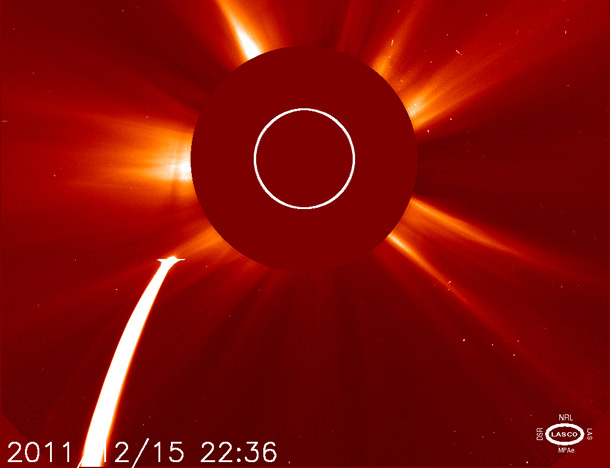Comet Lovejoy was only discovered in late November, but it’s had quite a ride. It was quickly determined to be a Sun-grazer, the kind of comet that plunges down very close to the Sun in its orbit. The date of this solar close encounter: yesterday!
 That’s a shot of it using SOHO, a solar observatory orbiting the Sun. The Sun itself is blocked by a mask, and the white circle represents its outline. The comet is obvious enough! The line through the top of it is not real; that’s called blooming and it happens sometimes when a bright object is seen by a digital detector. The electrons in the chip overflow the pixels and leak into adjacent ones. The comet got very bright as it neared the Sun, almost as bright as Venus! This picture, taken on December 15th at 22:36 UT, was shortly before closest approach: a mere 180,000 km (110,000 miles) from the Sun’s searing surface.
Amazingly, after the comet screamed past the Sun, and to the surprise of many, it survived. A lot of comets don’t make it through such an event, but this one did. Here’s a video of the comet reappearing from behind the Sun, as seen by SDO; watch closely or you’ll miss it!
But on the way down it had several interesting things happen to it. It had a companion (scroll down to December 14, 19:00 UT for the short video and tip on how to see the very faint second comet), for one. For another, it developed two distinct tails, which happens in comets fairly often. One is made of dust – ground up rock, essentially – and the other gas that gets ionized as it’s stripped off by the solar wind.
My favorite video shows the comet approaching the Sun as seen by STEREO; a special processing technique was used involving subtracting successive frames in the sequence, which eliminates the bright background and leaves sharper objects like stars and comets… and ripples in the solar wind. Watch as the comet moves toward the Sun, and see the tail wiggle as changes in the density of the solar wind buffet the beleaguered traveler:
Isn’t that cool? And how long do you think it’ll take some person with, um, odd sensibilities to use this video to claim the comet is alive, and some sort of cosmic spermatozoa?
But if you’d rather stick to facts – because c’mon, this is pretty amazing stuff already - then check out the fun Geeked on Goddard blog (and follow them on Twitter), as well as the Sungrazer website for more info on this scrappy little comet.
Image credit: NASA/SOHO
That’s a shot of it using SOHO, a solar observatory orbiting the Sun. The Sun itself is blocked by a mask, and the white circle represents its outline. The comet is obvious enough! The line through the top of it is not real; that’s called blooming and it happens sometimes when a bright object is seen by a digital detector. The electrons in the chip overflow the pixels and leak into adjacent ones. The comet got very bright as it neared the Sun, almost as bright as Venus! This picture, taken on December 15th at 22:36 UT, was shortly before closest approach: a mere 180,000 km (110,000 miles) from the Sun’s searing surface.
Amazingly, after the comet screamed past the Sun, and to the surprise of many, it survived. A lot of comets don’t make it through such an event, but this one did. Here’s a video of the comet reappearing from behind the Sun, as seen by SDO; watch closely or you’ll miss it!
But on the way down it had several interesting things happen to it. It had a companion (scroll down to December 14, 19:00 UT for the short video and tip on how to see the very faint second comet), for one. For another, it developed two distinct tails, which happens in comets fairly often. One is made of dust – ground up rock, essentially – and the other gas that gets ionized as it’s stripped off by the solar wind.
My favorite video shows the comet approaching the Sun as seen by STEREO; a special processing technique was used involving subtracting successive frames in the sequence, which eliminates the bright background and leaves sharper objects like stars and comets… and ripples in the solar wind. Watch as the comet moves toward the Sun, and see the tail wiggle as changes in the density of the solar wind buffet the beleaguered traveler:
Isn’t that cool? And how long do you think it’ll take some person with, um, odd sensibilities to use this video to claim the comet is alive, and some sort of cosmic spermatozoa?
But if you’d rather stick to facts – because c’mon, this is pretty amazing stuff already - then check out the fun Geeked on Goddard blog (and follow them on Twitter), as well as the Sungrazer website for more info on this scrappy little comet.
Image credit: NASA/SOHO
Lovejoy lives!
Advertisement